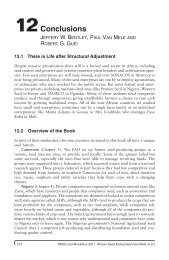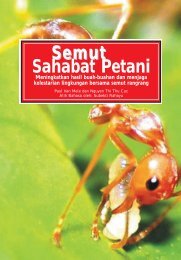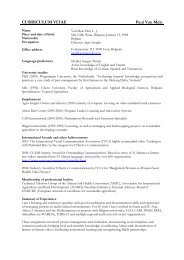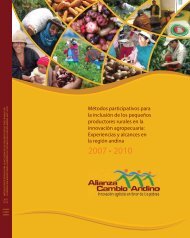Video-mediated farmer-to-farmer learning for sustainable agriculture
Video-mediated farmer-to-farmer learning for sustainable agriculture
Video-mediated farmer-to-farmer learning for sustainable agriculture
Create successful ePaper yourself
Turn your PDF publications into a flip-book with our unique Google optimized e-Paper software.
3.4 <strong>Video</strong> uptake and use<br />
3.4.1 Flexibility in use<br />
Agricultural training videos can be used in different ways, either directly by <strong>farmer</strong>s themselves or<br />
by any organization interacting with them (Table 3). An added advantage of video is that (apart<br />
from the rare use of video on mobile phones) they are mainly viewed by groups or by entire<br />
communities. Whether facilitated by an outside agency or watched with the family or neighbours,<br />
watching a video always provokes discussion afterwards.<br />
The fact that 28% of the respondents were able <strong>to</strong> broadcast video on TV indicates that TV stations<br />
are in need of content <strong>to</strong> fill their agricultural programs. About 21 respondents (5% of those who<br />
responded <strong>to</strong> this question) had ever used video clips on their mobile phone, but very few provided<br />
additional in<strong>for</strong>mation when probed.<br />
Table 3. Ways of using <strong>farmer</strong> training videos (n=394)<br />
Number %<br />
Small group viewing 314 80<br />
Ideas <strong>for</strong> extension 203 52<br />
Community viewing 201 51<br />
TV broadcast 110 28<br />
Radio broadcast 71 18<br />
Mobile phones 21 5<br />
Other 76 19<br />
All those who responded <strong>to</strong> the question on video use were contacted by email <strong>to</strong> ask if they had<br />
more details or any reports available. The results were sobering. Despite the many initiatives and<br />
experiences of individuals across the globe, there are almost no written accounts, curtailing the<br />
scope <strong>to</strong> obtain useful insights (but see Bentley and Van Mele 2011).<br />
The next two pages mainly draw on experiences from AfricaRice, as quite some action research was<br />
undertaken on video-<strong>mediated</strong> rural <strong>learning</strong> from 2005 <strong>to</strong> 2010.<br />
3.4.2 Compact discs <strong>for</strong> easy dissemination<br />
By 2010 AfricaRice had distributed the rice video CDs <strong>to</strong> over 200 organizations who in turn<br />
multiplied and shared them with over 800 organizations. Development agencies, networks and<br />
projects were most active in disseminating the video discs, followed by national research institutes<br />
and international NGOs. The first three made the largest number of copies and reached the widest<br />
range of organizations. Whereas universities, schools, networks and TV surely contributed <strong>to</strong><br />
making the videos more widely known, so far there is only anecdotal evidence of them multiplying<br />
and further distributing the videos.<br />
<strong>Video</strong> <strong>for</strong> <strong>farmer</strong>s Agro-Insight, Oc<strong>to</strong>ber 2011 page 12







